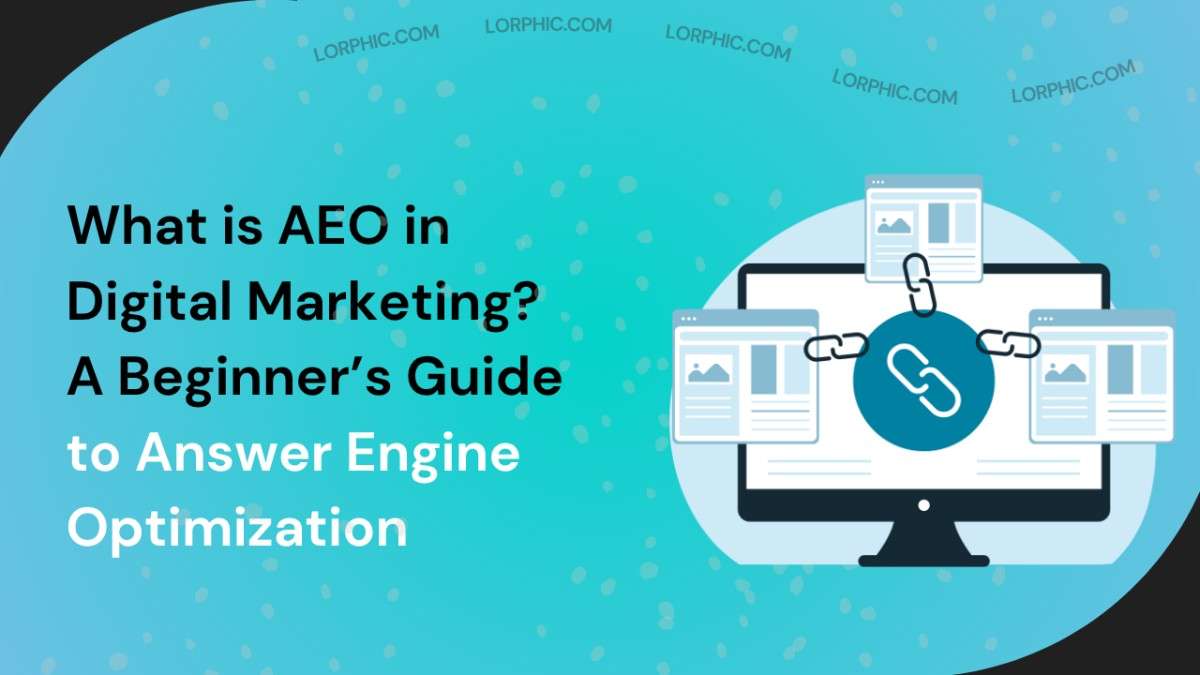We search differently. We don’t simply enter keyword strings into a search bar anymore; we ask questions. “How is the weather today?” “Where can I get a good coffee around here?” “How do I create a capsule wardrobe?” This paradigm from keyword strings to question-based searches has led to a new marketing practice: Answer Engine Optimization, or AEO.
If you’re a digital marketer, knowing AEO is fast becoming a necessity. It’s the solution to having your content appear not only on classic search engine results pages (SERPs), but also on voice assistants, featured snippets, and other AI platforms. This tutorial will take you through what is AEO in digital marketing, how it works, and why it’s a necessity of any contemporary digital marketing strategy.
What is AEO in Digital Marketing?
Answer Engine Optimization (AEO) is the practice of creating and structuring your content so it can directly answer users’ questions on search engines and AI-powered platforms.
In today’s world, people expect quick, clear, and accurate answers, whether they’re typing a query into Google or asking voice assistants like Siri, Alexa, or Google Assistant. AEO helps your content become the “go-to answer” that appears in places like:
- Google’s featured snippets (the highlighted answer box at the top of results)
- The “People Also Ask” section
- AI-driven responses in search or voice queries
You can think of AEO as the next step beyond SEO.
While traditional SEO (Search Engine Optimization) helps search engines understand what your content is about, AEO helps them understand which questions your content answers best.
As search engines and AI tools become more conversational, optimizing for answers instead of just keywords is becoming essential for better visibility, credibility, and engagement.
How Answer Engine Optimization Works in Digital Marketing?
Answer Engine Optimization (AEO) focuses on helping AI-driven search tools, like Google’s featured snippets, voice assistants, and chatbots, quickly find and deliver the most accurate answers to user questions.
Unlike traditional SEO, which relies heavily on keywords, AEO uses Natural Language Processing (NLP) and machine learning to understand the intent behind a query, not just the words used. This means your content needs to be written and structured in a way that’s clear, credible, and easy for both humans and AI to process.
Here’s how AEO works step by step:
1. Understand User Intent
AEO starts by identifying what users are really asking, in natural, conversational language. It looks beyond keywords to focus on the context and purpose behind each question (for example: “how to fix slow Wi-Fi” vs. “best Wi-Fi routers”).
2. Structure Content for AI
To make it easy for AI systems to extract and display your answer, your content should be well-organized. Use clear headings, bullet points, concise paragraphs, and structured data (like schema markup) so answer engines can instantly recognize your key points.
3. Provide Direct Answers
Your answer should appear immediately and clearly near the top of your content, ideally within the first few lines. This satisfies users’ need for quick information and signals to AI that your page provides a strong, relevant answer.
4. Ensure Credibility
Search engines and AI models prioritize authoritative, trustworthy sources. Build credibility by citing reliable references, maintaining factual accuracy, and using a consistent brand voice that demonstrates expertise.
5. Utilize Multiple Answer Engines
Finally, your optimized content can appear across different answer platforms, from Google’s featured snippets and “People Also Ask” sections to voice assistant replies (like Alexa, Siri, or Google Assistant) and even AI-powered chatbots.
Why AEO Matters in 2025?
Answer Engine Optimization (AEO) is quickly becoming a must-have strategy in digital marketing. With the rise of AI assistants and voice search, people are no longer just typing short keywords, they’re asking full, conversational questions and expecting instant, accurate answers.
As we move through 2025, here’s why focusing on AEO is more important than ever:
- The Growth of Voice Search: More people are using voice commands every day to find information through devices like Alexa, Siri, and Google Assistant. These voice searches are natural and question-based, which means traditional keyword optimization isn’t enough. AEO helps your content match the way people actually speak and search.
- The Power of Featured Snippets: Featured snippets, often called “Position Zero,” appear at the very top of Google results. They get the most attention and clicks because they provide instant answers. AEO techniques are designed to help your content earn these top spots by giving search engines exactly what they need, clear, structured, and accurate responses.
- Meeting Modern User Expectations: Today’s users want quick, reliable information, not long lists of links to dig through. By using AEO to deliver direct answers, you build trust, improve user experience, and position your brand as an authority people rely on. This often leads to better engagement and higher conversions.
- Preparing for the Future of Search: Search engines and AI tools are becoming smarter every year. They’re focusing more on understanding intent, context, and accuracy. AEO embraces these same principles by promoting clear, well-structured, and user-focused content. Adopting AEO today helps you stay ahead as search continues to evolve.
Core Elements of AEO Strategy
If you want your content to stand out in an AI-driven search world, you need to optimize it for answers, not just keywords. A successful Answer Engine Optimization (AEO) strategy focuses on understanding what people ask, how they ask it, and how AI systems interpret your content.
Here are the key elements that make an effective AEO strategy in 2025:
1. Understand User Intent
AEO begins with understanding what users truly want to know. Go beyond keywords to uncover the real intent behind their questions. Use tools like Google’s People Also Ask, AnswerThePublic, and Semrush to discover common queries, or check your own customer support logs and social media comments. These insights reveal exactly what your audience is curious about.
2. Create Clear, Direct, and Helpful Answers
Once you know what people are asking, your goal is to deliver straightforward, easy-to-digest answers.
- Use questions as subheadings and answer them directly below.
- Keep answers concise (40–60 words works best for featured snippets).
- Use bullet points, numbered lists, or tables for step-by-step or comparison-based queries, these are formats AI easily understands and often highlights.
Writing in conversational language also helps align your content with how users naturally speak to voice assistants.
3. Implement Structured Data (Schema Markup)
Structured data helps search engines and AI tools interpret your content accurately. Adding schema.org markup such as FAQPage, HowTo, or QAPage tags signals that your page contains questions and answers. This increases your chances of being featured in snippets, voice results, and AI-generated answers.
4. Build Authoritative and Trustworthy Content
AI systems prioritize credible sources. To build authority:
- Create comprehensive pillar pages supported by in-depth subtopics.
- Follow Google’s E-E-A-T principles, Experience, Expertise, Authoritativeness, and Trustworthiness.
- Support your statements with accurate data, reputable sources, and original insights.
This combination positions your brand as a reliable expert within your niche.
5. Optimize for Technical Performance
A technically sound website is the foundation of AEO. Make sure your site loads quickly, works smoothly on mobile devices, and uses HTTPS for security. Keep your HTML clean and easy for AI crawlers to navigate so your answers can be indexed and ranked more effectively.
6. Diversify with Multi-Format Content
AI systems now analyze more than text. Enhance your pages with images, videos, infographics, and interactive elements, all properly labeled with alt text, captions, and transcripts. This makes your content more engaging for users and easier for AI to understand in different formats.
7. Strengthen Topical Authority
To become a recognized source, create content clusters that fully cover your main topics. When your website consistently publishes well-structured, interlinked articles on related subjects, AI and search engines begin to identify your brand as a trusted knowledge source, which can help you appear in knowledge graphs and answer cards.
8. Include FAQ Sections
Adding a clear, well-organized FAQ section at the end of relevant pages is one of the simplest and most effective ways to boost AEO. It provides direct answers to specific user queries and is highly favored by both voice search and AI-generated responses.
SEO vs AEO: Key Differences
While SEO and AEO are closely related and share many of the same principles, there are important distinctions to understand.
Aspect | Traditional SEO | Answer Engine Optimization (AEO) |
| Primary Goal | Rank a webpage for a target keyword. | Get a specific piece of content featured as a direct answer. |
| Focus | Keywords and backlinks. | User intent and question-based queries. |
| Content Format | Long-form articles, blog posts. | Concise paragraphs, lists, tables, and FAQ sections. |
| Key Tactic | On-page optimization, link building. | Structured data (Schema), direct content structuring. |
| Success Metric | Organic ranking position (e.g., #1, #2). | Position Zero (featured snippet), voice search answer. |
Ultimately, AEO should be seen as a specialized component of your broader SEO strategy. A strong foundation in SEO is necessary for AEO to be effective.
Final Thoughts
Answer Engine Optimization is not a fleeting trend; it’s a fundamental shift in how we must approach content creation and digital marketing. By focusing on answering your audience’s questions directly and clearly, you align your strategy with the direction that search technology is heading.
Start small. Identify a few key questions your customers ask, create a well-structured FAQ page using schema markup, and measure the results. As you begin to see your content appear in answer boxes and get chosen by voice assistants, you’ll understand the power of thinking like an answer engine. The brands that master AEO today will become the trusted authorities of tomorrow.




